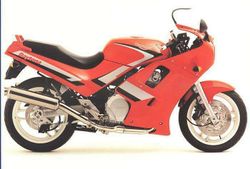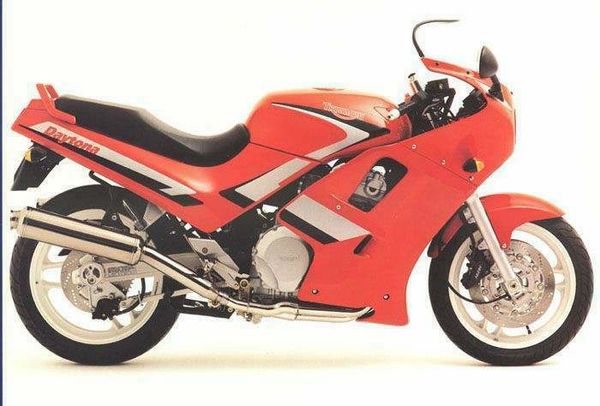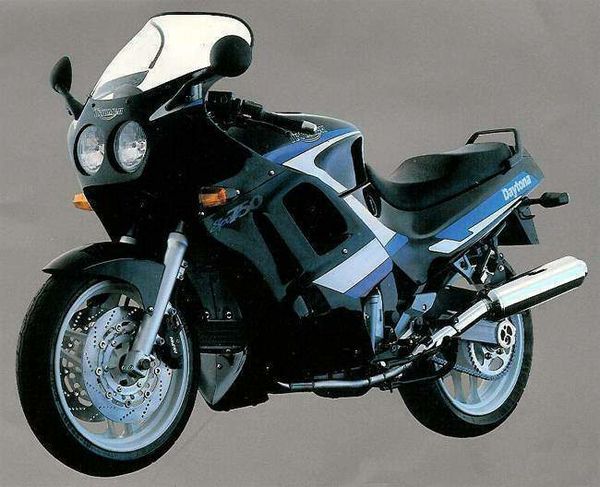Triumph Daytona 750: history, specs, pictures
 |
|
| Triumph Daytona 750 | |
| Manufacturer | |
|---|---|
| Also called | Daytona 750 (reduced effect #2), Daytona 750 (reduced effect) |
| Production | 1991 - 1994 |
| Class | Sport touring |
| Engine | liquid-cooled, 4-stroke, transverse three cylinder, 4 valves per cylinder |
| Bore / Stroke | 75.9mm x 75.9mm |
| Compression ratio | 11:1 |
| Top Speed | 134 mph (216 km/h) |
| Horsepower | 96.96 HP (72.3 KW) @ 8750RPM |
| Torque | 48.68 ft/lbs (66.0 Nm) @ 8500RPM |
| Fuel System | 3x 36mm BST CV, carburetor |
| Air Filter | K&N TB-9091 `91-95[1] |
| Transmission | Gear box: 6-speed, manual Final Drive: chain |
| Suspension | Front: 43mm telescopic forks, preload, compression and rebound damping adjustment Rear: tri-link monoshock, adjustable preload and rebound damping |
| Brakes | Front: 2x 296mm discs 4 piston calipers Rear: single 255 mm disc with 2-piston calipers |
| Front Tire | 120/70-17 |
| Rear Tire | 160/60-18 |
| Weight | 218.0 kg (wet) |
| Oil Filter | K&N KN-192[1] |
| Fuel Capacity | 6.6 Gallon (25.00 Liters) |
| Manuals | Service Manual |
The Triumph Daytona 750 was a liquid-cooled, 4-stroke, transverse three cylinder, 4 valves per cylinder Sport touring motorcycle produced by Triumph between 1991 and 1994. It could reach a top speed of 134 mph (216 km/h). Max torque was 48.68 ft/lbs (66.0 Nm) @ 8500 RPM. Claimed horsepower was 96.96 HP (72.3 KW) @ 8750 RPM.
Engine[edit | edit source]
The engine was a liquid cooled liquid-cooled, 4-stroke, transverse three cylinder, 4 valves per cylinder. A 75.9mm bore x 75.9mm stroke result in a displacement of just 749.0 cubic centimeters. Fuel was supplied via a double overhead cams/twin cam (dohc).
Drive[edit | edit source]
The bike has a 6-speed, manual transmission. Power was moderated via the wet multi-disc, manual.
Chassis[edit | edit source]
It came with a 120/70-17 front tire and a 160/60-18 rear tire. Stopping was achieved via 2x 296mm discs 4 piston calipers in the front and a single 255 mm disc with 2-piston calipers in the rear. The front suspension was a 43mm telescopic forks, preload, compression and rebound damping adjustment while the rear was equipped with a tri-link monoshock, adjustable preload and rebound damping. The Daytona 750 was fitted with a 6.6 Gallon (25.00 Liters) fuel tank.
1992 Triumph Daytona 750[edit | edit source]
The 1991 MY Triumph Daytona 750 sports a four-stroke, liquid-cooled, 749cc, three-cylinder engine that produces 97 horsepower and 66 Nm of torque, which is impressive when you think about its age. Seeing as how the British engineers have tweaked the lump for improved mid-range power delivery, you start to understand why the Daytona is such an esteemed family that still endures.
Whether on a daily commute or a weekend haul across the country, the two-wheeler is up for the task, with a comfortable riding position, a full fairing for protection against the elements and a rigid, yet, nimble chassis, make it a sound alternative to the noisy and angry Japanese tourers available on the market.
1993 Triumph Daytona 750[edit | edit source]
The 1992 MY Triumph Daytona 750 is a sporty, middleweight bike, with British styling and engineering written all over it. Sharing the engine and chassis with the Trident 750, you know it will perform well, but add in full fairing and some other accessories that just don't go well, stylish-wise, with the Trident, and you get a nimble little sporty tourer great for weekends spent in the countryside.
The machine sports a three-cylinder, liquid-cooled, four-stroke, 749cc lump that gives it that unique Triumph feel, and the fact that it's a three-cylinder makes it sound rather special, even though Triumph fitted it with a sports exhaust system and a silencer.
1994 Triumph Daytona 750[edit | edit source]
For those riders that prefer alternatives to the Japanese giants in the sport department, the Brits from Triumph have launched the 1994 MY Daytona 750. Sharing most of its internal bodyparts and engine with the Trident 750, they have fitted the machine with full-fairing and have adjusted the handlebars and seat height for a proper touring rider position.
A rigid, yet versatile frame, coupled to a 43mm telescopic fork and a tri-link monoshock rear suspension, make the Daytona excellent for weekend trips along countryside roads, making the rider burst with joy at every bend.
References[edit | edit source]
- ↑ 1.0 1.1 2019 K&L Supply Co Catalog. K&L Supply Co. 2019.

